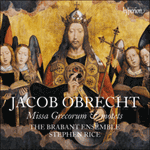The six-part
Salve regina is Obrecht’s most expansive setting of this popular antiphon. The setting is alternatim, with five sections of plainchant framing four of polyphony. Obrecht’s texture is a higher-pitched one than that of most of his works, with three voices out of the six apparently being intended for boys’ voices (both the second and third voice down bear the inscription ‘secundus puer’ in the Munich manuscript used here). The work is a compositional tour-de-force in terms of its control of tessitura, form, and manipulation of plainchant. Notable moments include the opening of the second polyphonic section (‘Ad te suspiramus’), which weaves a high-voice texture for thirteen breves before the three lower voices enter en bloc, and the ecstatic ‘Et Jesum’ with which the following segment of polyphony begins.
from notes by Stephen Rice © 2018
Le
Salve regina à six voix, une œuvre de dévotion, est la plus importante de cette antienne populaire composée par Obrecht. La musique est alternatim, avec cinq sections de plain-chant encadrant quatre sections de polyphonie. La texture d’Obrecht est plus aiguë que celle de la plupart de ses œuvres, avec trois voix sur six apparemment destinées à des voix de jeunes garçons (la deuxième et la troisième voix vers le grave portent l’inscription «secundus puer» dans le manuscrit de Munich utilisé ici). Cette œuvre est un tour de force en matière de composition au niveau de la maîtrise de la tessiture, de la forme et de la manipulation du plain-chant. Les moments remarquables sont le début de la deuxième section polyphonique («Ad te suspiramus»), qui tisse une texture de voix aiguë pour treize brèves avant que les trois voix plus graves entrent en bloc, et l’«Et Jesum» extatique sur lequel commence le segment de polyphonie suivant.
extrait des notes rédigées par Stephen Rice © 2018
Français: Marie-Stella Pâris
Das sechsstimmige
Salve regina ist Obrechts längste Vertonung dieser beliebten Antiphon. Das Stück zeichnet sich durch die Alternatimspraxis auf, wobei fünf Cantus-planus-Abschnitte vier polyphone Teile umrahmen. Dieses Stück erklingt in einem höheren Register als die meisten anderen Werke Obrechts; drei der sechs Stimmen waren offenbar für Knabenstimmen gedacht (sowohl die zweite als auch die dritte Stimme von oben ist in dem hier verwendeten Münchner Manuskript mit „secundus puer“ bezeichnet). Das Werk ist eine kompositorische Glanzleistung, was die Handhabung der Gesangslage, Form und Behandlung des Cantus planus anbelangt. Zu besonders bemerkenswerten Momenten gehört der Beginn des zweiten polyphonen Abschnitts („Ad te suspiramus“), wo über 13 Breven hinweg eine Passage für hohe Stimmen gewebt wird, bevor die drei tieferen Stimmen zusammen einsetzen, sowie das ekstatische „Et Jesum“, womit das folgende Polyphonie-Segment beginnt.
aus dem Begleittext von Stephen Rice © 2018
Deutsch: Viola Scheffel
Nato a Gand, Jacob Obrecht impiega la maggior parte della propria carriera musicale a servizio delle chiese nella terra natale e, nonostante il grande talento, solo per breve tempo riesce a procurarsi un incarico nelle corti italiane. Nel 1485 vien licenziato dalla cattedrale di Cambrai per l’insufficiente cura del coro dei fanciulli e perché non sapeva amministrare le proprie risorse finanziarie (in quell’anno il capitolo accetta alcune sue composizioni per coprire i suoi debiti). A causa della cattiva salute si ritira nel 1500 e resta prevalentemente a Bergen op Zoom. Nel 1504 fa un viaggio a Ferrara, dove l’anno seguente muore di peste. Il suo stile musicale è ricco d’invenzione e nel contempo spontaneo, e magistrale è il controllo delle immense strutture sonore. La sontuosa
Salve Regina a 6 voci è di dimensioni monumentali e si situa tra le più belle intonazioni di questa popolare preghiera. Si ritiene sia stata scritta negli anni ’80 del Quattrocento ed è cosparsa di brevi sezioni della melodia tradizionale in cantus planus (canto gregoriano), liturgicamente destinata ad esser cantata dopo Compieta nel periodo che va dall’Avvento alla Candelora.
David Skinner © 1998
Italiano: Bruno Meini


 Obrecht: Missa Grecorum & motets
Obrecht: Missa Grecorum & motets
